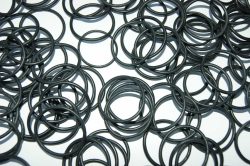How Are O Rings Manufactured?
M Barnwell Services explains How Are O Rings Manufactured?
Please find below our step-by-step guide on how O Rings are manufactured.
STEP 1: O Rings Moulding
The first step in the O Ring manufacturing process is selecting the correct tools for moulding. The correct tools are dependent on the size of the O Ring that is being manufactured. Smaller sizes are typically stored in a computerised system, with tools for larger O Rings stored in racking. Each O Ring is comprised of two halves, the top and bottom.
Step 2: Milling
Correct material selection is key to seal performance. Elastomers derive their performance characteristics from the ingredients and additives that are in them. Fillers. Additives and other ingredients are mixed into the elastomer material using a milling machine.
Step 3: Extrusion
The elastomer material arrives at the next stage as a sheet which is cut into strips and inserted into an extruder. Once inside, the material is heated up to reduce its viscosity and forced through a die, which produces lengths of cord. The size of the die aperture is carefully selected based on the finished diameter of the O Ring that is required.
Step 4: Moulding
During the moulding stage, the cord is cut to the size and placed into one-half of the heated mould tools, which are fixed to the two platens of the press. When the two halves of the tool close, the elastomer material is moulded into an O Ring shape. It is left in the press for a short length of time to start the curing process. When the press opens, the O Ring is carefully removed from the mould. This technique of manufacturing O rings is called compression moulding. Larger O Rings, up to two and a half metres are precision moulded on one of Europe’s largest moulding presses at the facility.
Step 5: Flash
Once moulded, the O Rings often have excess material around the sides, where the two halves of the mould meet. This is known as flash. In the next production, called finishing, this flash is removed in a number of ways to produce a perfectly round O Ring Drumming. The O Rings are placed in a drum of rotating stones which rub the excess flash off.
Step 6: Buffing
Larger O Rings are placed under a buffing wheel. The abrasive action rubs the flash off.
Step 7: Cyro
Small O Rings that are too delicate for any of the other finishing methods are placed under a drum. This rotates within a cryogenic environment. Liquid nitrogen cools the elastomer O Rings down until the flash is brittle and can be removed by shot blasting with grit.
Step 8: Curing
The De-flashed O Rings are placed in ovens to complete the curing process. The length of time they are in the oven depends on the type of elastomer, but typically ranges from two to eighteen hours.
Step 9: Inspection
Once cooled the O Rings are now ready for quality inspection. Trained operators use 2x magnification, as stated in ISO 3601 Standard, to visually inspect the O Rings for visual defects. The O Rings are measured using optical non-contact measuring equipment which accurately checks the dimensions of the finished part. The O Rings are then ready to be packaged as per the customer’s requirements. Once bagged and labelled the O Rings are packaged by the despatch team, ready to be shipped around the world.
M Barnwell Services are the largest independent manufacturer, stockist and distributor of O Rings and Back-Up Rings in the UK. With 50 million in stock, we supply to over 5000 customers globally every month – quickly and reliably.
You Are In Safe Hands – so much more than O Rings…
We have an extensive range of seal materials including Perfluoroelastomer (FFKM), Nitrile (NBR), Hydrogenated Nitrile (HNBR), Viton™ (or FKM/FPM), Viton™ A, Viton™ B, Viton™ GF, Viton™ GLT, Viton™ GFLT, Viton™ ETP, Ethylene Propylene (EPDM), Silicone (VMQ), Polytetrafluoroethylene (PTFE) Fluorosilicone (FVMQ) and Medical Grade. These can all be measured to imperial (BS1806, ISO 3601) and metric (BS4518) sizes, shore hardness and to a range of International, National and industry specifications, grades and approval standards.
If you would like more information about our range, download our catalogue, visit the Seal Maker Page or contact a member of the team. E & OE.
